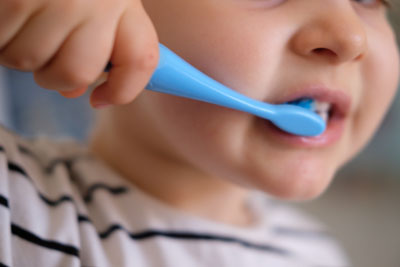Making an impact: Bridging the gap in rural pediatric dentistry
“A lot of parents don’t understand that cavities can develop as soon as the first tooth erupts,” she says. “Getting a dental home for your child by age one is so important. We can identify any risk factors for dental disease and treat problems early. It’s less expensive and gets the child on the right trajectory for great oral health. It not only impacts their smile and keeps them out of pain, but it also has a lot of overlap with general medical health.”
 |
| Jessica Meeske, DDS |
In small towns across the country, the situation is similar to Nebraska: According to an American Academy of Pediatric Dentistry (AAPD) technical brief, two-thirds of the nation’s federally designated dental health professional shortage areas are in rural America. As a result, children in rural areas are more likely to have poor oral health compared to their urban peers. To address the need for pediatric dental care in rural communities, stakeholders are working together to overcome barriers and find sustainable solutions.
Rural barriers and opportunities
For rural residents and health care providers, AAPD identifies barriers to oral health care that sound familiar: transportation limitations, long travel distances to providers, higher poverty rates, lower oral health literacy, and fewer dentists that accept Medicaid. According to Erica Caffrey, DDS, University of Maryland School of Dentistry clinical assistant professor and AAPD Council for Clinical Affairs chair elect, the biggest challenge is dental workforce shortages.“Some barriers to oral health are the same for rural and urban populations and have to do with structural and social determinants of health – socioeconomic factors, income, education,” she says. “Many times, dental care simply is not affordable. When it comes to rural oral health, geographically one of the biggest problems is the shortage of dental providers.”
 |
| Erica Caffrey, DDS |
In recent years, telehealth has increasingly helped rural communities cope with shortages of dentists and other oral health care providers – but for individuals who lack access to technology, digital care remains largely out of reach. Particularly during the pandemic, the opportunities surrounding telehealth became more apparent, such as reduced travel time, lower costs, and more flexible office visits. But Caffrey points out that it only works if rural residents have computers and high-speed internet.
“As we saw during the pandemic, those without access to technology like broadband and computers were unable to participate in telehealth services,” she says. “If we expect to use teledentistry more in the future, we need to make sure people have better access to digital technology.”
| "Getting a dental home for your child by age one is so important" – Jessica Meeske |
While rural kids may be more difficult to reach initially, once a connection has been established, the close-knit nature of small towns can help providers do their jobs. In rural Nebraska, Meeske and her team have grown her clinic from a single office to five locations serving the entire state. This is due in large part to community partnerships with Head Start, WIC, and the local Medicaid agency, but also rural residents’ knack for taking care of each other.
“I love being in rural America because you know everybody,” she says. “You know where your community’s assets are, and it’s much easier to get your patients the help they need because you sit in church with them, and your kids are on the same soccer team. It’s very easy to get things done and expedite care and set up appointments.”
Improving oral health literacy
Community connections have also helped Meeske improve oral health literacy in rural Nebraska, as well as link families to resources that can treat related issues such as food insecurity or speech delays. She credits her rural environment with helping her develop expertise in many areas – unlike urban dentists, she says, rural providers don’t have resources at their fingertips, so they must learn to be creative and work with partners in other organizations.“If you can have increased collaboration between schools, county agencies, newspapers, other media services, and academic institutions, you are more likely to increase oral health literacy through consistent, widespread messaging,” she says.
“A lack of understanding of the effects of diet, preventive care, and routine visits can lead to more frequent ER encounters and lower use of dental services,” Caffrey adds. “It may become normalized to have poor oral health in some rural communities. There needs to be improved oral health literacy in rural communities to make individuals aware of the need for preventive services and routine dental care.”
 |
Caffrey underscores the short and long-term effects of misconceptions surrounding oral health, such as how an unhealthy diet contributes to dental decay or the idea that kids don’t need to see a dentist because they will lose their baby teeth anyway. Not only does poor oral health often contribute to disease and chronic pain, but it can also affect kids’ mental health by damaging their smile, social status, and self-esteem.
“If you had dental decay in your early years, you’re more likely to have it in your adult years as well,” Caffrey says. “Oral health can affect mental health as well as cardiac health and overall well-being. Along with obesity and asthma, poor oral health is one of the most common chronic diseases of childhood, so it’s important that we address it early on.”
The power of policy changes
In addition to education and outreach, Meeske says policy changes are the most powerful way to ensure more rural kids have access to high-quality oral health care. In particular, she emphasizes that loan repayment programs for pediatric dentists need to be enhanced to levels that match other health care providers. As a resident, Meeske noticed rural Nebraska hospitals were offering lucrative incentives to recruit her spouse, who is an OB-GYN – but as a pediatric dentist, she did not receive the same attention.“I called the Nebraska Office of Rural Health and asked why they offered such robust loan repayment for physicians and not for dentists,” she says. “Ultimately I wrote my own argument for why they should give pediatric dentists loan repayments. I looked up the stats – how many kids in how many counties I would serve and how many were on Medicaid. I got a letter back saying that not only would they accept me for loan repayment, but every pediatric dentist who came after me.”
| "If we expect to use teledentistry more in the future, we need to make sure people have better access to digital technology." – Erica Caffrey |
The loan repayment incentive has made it easier for Meeske to recruit pediatric dentists to live and work in rural Nebraska. To grow the state’s future dental workforce even more, she starts early, working to identify and start mentoring future practitioners in middle school and high school. In this way she has taken a grow-yourown approach to building a provider pipeline.
“In rural areas you have to think outside the box and be creative on how to build out your team of people,” Meeske says. “The long-term effects of changing the loan repayment policy probably had more to do with helping kids than just me as one pediatric dentist, drilling and filling on teeth one patient at a time. Now I don’t hesitate at all – if I think there’s a policy that doesn’t serve kids well, I do what I have to do to make sure kids have what they need.”
Along with enhancing loan repayment and encouraging rural residents to participate in the dental workforce, Caffrey cites solutions such as school-based sealants, mobile dental services, community water fluoridation, and Medicaid reform with sustainable reimbursement rates as essential to increasing oral health care access for rural residents.
| "Oral health can affect mental health as well as cardiac health and overall well-being." – Erica Caffrey |
“In small towns, people want to take care of people in their community,” Meeske says. “These are all of our kids. Whether you’re a teacher, a daycare provider, a pastor, a dentist, a physician – we’re all working as a village to make sure a kid gets what they need in order to be pain free, successful in school, and ready to launch by the time they grow up.”
“There’s no one solution – there is no magic bullet,” Caffrey adds. “Each of these communities requires an individualized solution. The biggest way to improve the oral health of these communities is to go into them and ask for their input and help in creating their programs.”
